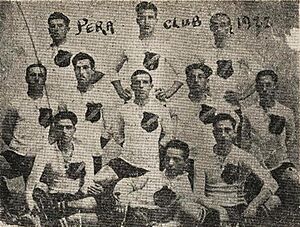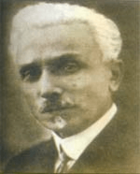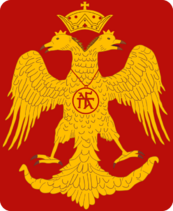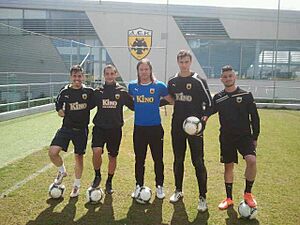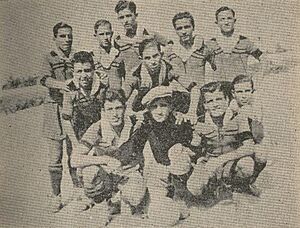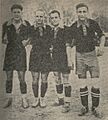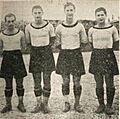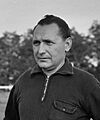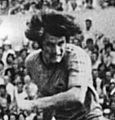History of AEK Athens F.C. facts for kids
AEK Athens F.C. is one of the most famous and historic football clubs in Greece. They have a long and exciting story, with many ups and downs. AEK won their first championship in 1939. Since then, they have become one of Greece's most successful football teams.
Contents
How AEK Athens Started
Many Greek people lived in Constantinople (now Istanbul, Turkey) a long time ago. They loved sports and had many clubs. Clubs like Énosis Tataoúlon and Ermís helped keep Greek sports and culture alive. These clubs were very important before World War I.
After the war, soldiers from France and England came to Constantinople. City clubs often played against teams made by these soldiers. Places like Taxim and Pera became busy with weekly games. They played football, but also other sports like cycling and boxing.
One of the best football teams was called The Greek Football Team. It was part of a bigger sports club named Ermís. But after a war between Greece and Turkey, many Greek athletes had to leave Constantinople. They moved to cities like Athens and Thessaloniki in Greece.
The Early Years (1924–1959)
Forming a New Club (1924–1929)
In 1924, a group of Greek refugees from Constantinople met in Athens. They wanted to create a new club called AEK. Their goal was to offer sports and fun activities. This was for the thousands of refugees who had moved to Athens.
AEK's first friendly game was in October 1924. They tied 1–1 with Atromitos. Their first official match was on December 14, 1924. They won 4–2 against Goudi.
AEK quickly became very popular in the 1920s. Many new immigrants joined the club. Also, some club leaders had strong political ties and money. At first, AEK didn't have its own field. They played games in different places around Athens.
Konstantinos Spanoudis was AEK's first president. He was a journalist and friend of the Greek Prime Minister. In 1926, he asked the government for land. This land in Nea Filadelfeia was meant for refugee homes. But it was given to AEK for a sports ground. By 1930, the club officially owned the land.
In 1927, AEK, Panathinaikos, and Olympiacos left the local Athens league. They had a disagreement with the new Hellenic Football Federation. They formed their own group and played friendly matches. But in 1928, they rejoined the main federation.
In 1928, the Prime Minister approved plans for AEK's new stadium. It would be called the AEK Stadium. This stadium would be their home for the next 70 years.
First Trophies (1929–1940)
The AEK Stadium was finished in 1930. The first game there was a friendly match against Olympiacos. It ended in a 2–2 draw.
In 1932, AEK won the first-ever Greek Football Cup. They beat Aris 5–3 in the final. This was the club's very first trophy!
In 1933, former star player Kostas Negrepontis became the team's coach. He built a very strong team. Key players included Kleanthis Maropoulos and Tryfon Tzanetis. They were one of the best attacking duos in Greek football.
AEK had great success in the late 1930s. They won the Greek Championship in 1939 and 1940. In 1939, they also won the Cup. This was the first time a Greek team won both the league and the cup in the same year! This is called a "double."
During World War II (1940–1945)
Football games became rare during World War II. In 1942, Panathinaikos and AEK planned a friendly match. It was to raise money for a hospital. But the occupation forces wanted some of the money. The team captains refused. About 15,000 fans protested. This game became known as the "Resistance Derby."
Sadly, in June 1944, AEK player Spyros Kontoulis was killed. He was trying to escape from the Nazi forces. They were taking him to be executed for being part of the resistance.
After the War (1945–1959)
After World War II, AEK continued to win. With coach Jack Beby and star players, they won the Cup in 1949 and 1950. They also won the Athens regional championship in 1950.
In the 1950s, new stars joined the team. These included Giannis Kanakis, Andreas Stamatiadis, and Stelios Serafidis. In 1955, AEK signed Kostas Nestoridis. He became the best forward of his time. He was the league's top scorer in his first season.
AEK won the Cup again in 1956. They beat Olympiacos 2–1 in the final.
Entering the Top League (1959–1974)
In 1959, Greece started a new top football league called Alpha Ethniki. AEK, led by coach Lukas Aurednik, almost won the first season. They tied for first place but lost a play-off game. Kostas Nestoridis was the top scorer for many years in a row.
Over these years, AEK had different coaches. They won the league in 1963 under Jenő Csaknády. They also won the Greek Cup in 1964. This was a special win because the final wasn't played. The other teams were disqualified because of fan trouble.
AEK also started playing in European competitions. In 1963, they played in the European Cup for the first time. In 1964, they played in the Cup Winners' Cup. They even got their first European win against Dinamo Zagreb.
In 1968, AEK won the league again with coach Jenő Csaknády. They had a strong team that beat rivals like Olympiacos.
From 1968 to 1973, Branko Stanković was the coach. He built a new team with strong tactics. In 1969, AEK became the first Greek club to reach the quarter-finals of a European competition. They won the league again in 1971.
The Loukas Barlos Era (1974–1981)
In 1974, Loukas Barlos became the new president of AEK. He wanted to build a great team. He hired coach František Fadrhonc and brought in talented players. These included Christos Ardizoglou, Walter Wagner, and Georgios Dedes.
AEK played exciting football. They finished second in the league in 1975 and 1976. In 1976, they signed Thomas Mavros, who became a legendary player.
In the 1976–77 season, AEK made history in the UEFA Cup. They reached the semi-finals, becoming the first Greek club to go so far. They beat strong teams like Derby County and Red Star Belgrade.
In 1977, Zlatko Čajkovski became the coach. With amazing players like Dušan Bajević and Thomas Mavros, AEK played fantastic football. They easily won the league and the Cup in 1978. This was their second "double" in history! Thomas Mavros was the top scorer.
In 1978, the famous Ferenc Puskás became AEK's coach. They had another great season. They beat Porto 6–1 in the European Cup, which was a huge win. AEK won the league again in 1979 after a play-off game. Thomas Mavros was once again the league's top scorer.
In 1979, football in Greece became professional. Loukas Barlos became the first owner of AEK. He also built a new, modern stand at the stadium. However, the team faced some challenges and changes in players.
Challenges and Rebuilding (1981–2013)
After Loukas Barlos left in 1981, AEK went through some tough years. They had many changes in coaches and players. The team struggled to win trophies.
In 1983, AEK won the Greek Cup again. But overall, the club faced financial problems and changes in leadership. They moved to the Olympic Stadium for a few years.
In 1988, AEK returned to their home stadium. They finished second in the league that year.
The Golden Years (1988–1997)
This period was a very successful time for AEK. Dušan Bajević returned as coach in 1988. He built a strong team that won many titles.
In 1989, AEK won the league in a thrilling final game. They beat Olympiacos 1–0 away from home. They also won the Super Cup in 1989 and the League Cup in 1990.
AEK won the league three times in a row from 1992 to 1994. This was a fantastic achievement! Key players during this time included Vasilis Dimitriadis and Alexis Alexandris, who were top scorers.
In 1994, AEK became the first Greek club to play in the new UEFA Champions League group stage. They played against big teams like Ajax and Milan.
In 1996, AEK won the Greek Cup with a huge 7–1 victory in the final. This was a record win! However, coach Bajević left the club after this season.
New Ownership and Ups and Downs (1997–2004)
After Bajević left, AEK had new coaches and owners. They continued to compete in European competitions. In 1997, they reached the quarter-finals of the Cup Winners' Cup. They also won the Super Cup in 1996 and the Greek Cup in 1997.
In 1998, a big English company called ENIC Group bought most of AEK's shares. They brought in new players and coaches. In 1999, AEK played a friendly match against Partizan in Belgrade during a difficult time for the country. This showed the club's strong spirit.
In 2000, a big earthquake damaged AEK's stadium. They had to play their home games in other stadiums. Despite this, they won the Greek Cup in 2000. In that final, Demis Nikolaidis showed great sportsmanship. He told the referee to disallow a goal he scored with his hand.
In 2001, Fernando Santos became the coach. In 2002, AEK almost won the league but finished second. They did win the Greek Cup that year.
In 2002, Dušan Bajević returned as coach. This was a bit controversial for some fans. AEK played in the Champions League group stage. They made a record by drawing all six of their matches! In 2003, their home stadium was sadly torn down. This meant AEK had to play in different stadiums for many years.
Financial Struggles and Relegation (2004–2013)
AEK faced serious financial problems. Many important players left. In 2004, former star player Demis Nikolaidis became the new president. He worked hard to save the club from bankruptcy. Fernando Santos returned as coach.
AEK continued to play in European competitions. In 2006, they reached the Champions League group stage again. They even beat big teams like Lille and Milan in 2006.
However, the financial problems continued to grow. The team struggled in the league. In 2013, after a tough season and losing points due to fan trouble, AEK was relegated from the top league. This was a very sad moment for the club.
The Second Melissanidis Era (2013–Present)
Climbing Back Up (2013–2015)
After being relegated, AEK faced even more challenges. They had to go down to the third division. But Dimitris Melissanidis, a former owner, returned. He promised to build a new stadium and bring the club back to the top.
Traianos Dellas, a former player, became the coach. The team was filled with young Greek players. They easily won promotion from the third division in 2014.
In 2015, AEK continued their climb. They won the second division and were promoted back to the Super League! This was a huge step for the club.
Return to Glory (2015–Present)
AEK returned to the Super League in 2015. They won the Greek Cup in 2016, beating Olympiacos in the final.
In 2017, Manolo Jiménez returned as coach. AEK had a great season. They reached the Cup final again but lost in a controversial match. However, they secured a spot in the Champions League qualifiers.
In the 2017–18 season, AEK had an amazing year! They won the Super League title. This was their first league championship in 24 years! They also reached the Cup final for the third year in a row. This was a truly golden season for AEK.
Since then, AEK has continued to compete at the top. They have faced challenges but always fight hard. In 2022, AEK moved into their brand new home, the Agia Sophia Stadium. This stadium is a symbol of their return to strength.
In the 2022–23 season, under coach Matías Almeyda, AEK had another incredible year. They won both the Super League title and the Greek Cup, achieving their third "double" in history! This showed that AEK Athens is back as a top force in Greek football.
AEK Athens: Club Identity
Team Colors and Symbol

In 1924, AEK Athens chose a double-headed eagle as their symbol. This eagle is a strong reminder of their history. It connects the club to Constantinople, where many of its founders came from. The double-headed eagle was also a symbol of the Byzantine Empire.
AEK's main colors are yellow and black. These colors also come from their connection to Constantinople. Yellow represents hope for the Greek refugees to return home. Black shows sadness for losing their homes. These colors are also seen on the flag of the Greek Orthodox Church.
The team's third kit is usually blue and white. These are the colors of the Greek flag. Sometimes, they have used dark red, which was a color from the Byzantine Empire's flag.
AEK Athens usually wears yellow and black striped or plain yellow shirts. They wear black shorts and yellow or black socks. In the 1990s, some of their kits had a large double-headed eagle design. One of these was even voted "Kit of the season" by UEFA!
Stadiums
AEK Athens has played in a few different stadiums over the years.
| Stadium Name | Capacity | Years |
|---|---|---|
| Nikos Goumas Stadium | 24,729 | 1930–1985 1987–2003 |
| Athens Olympic Stadium | 69,618 | 1985–1987 2004–2022 |
| Agia Sophia Stadium | 32,500 | 2022– |
Training Facilities
AEK Athens trains at the Spata Training Centre. This modern facility was built in 2010. It has been updated and expanded over the years. In 2022, a new pitch with stands was built there. It's called "Serafidio Stadium." It hosts games for AEK's B team and friendly matches.
Youth Academy
AEK was the first Greek club to start a youth academy. This happened way back in 1934. Many famous players have come from AEK's youth system.
Some notable players who grew up in AEK's academy include:
- Tryfon Tzanetis (1933–1950)
- Kleanthis Maropoulos (1934–1952)
- Andreas Stamatiadis (1950–1969)
- Stelios Manolas (1978–1998)
- Spyros Ikonomopoulos (1977–1996)
- Sokratis Papastathopoulos (2005–2008)
- Kostas Manolas (2009–2012)
- Konstantinos Galanopoulos (2015–)
Images for kids


